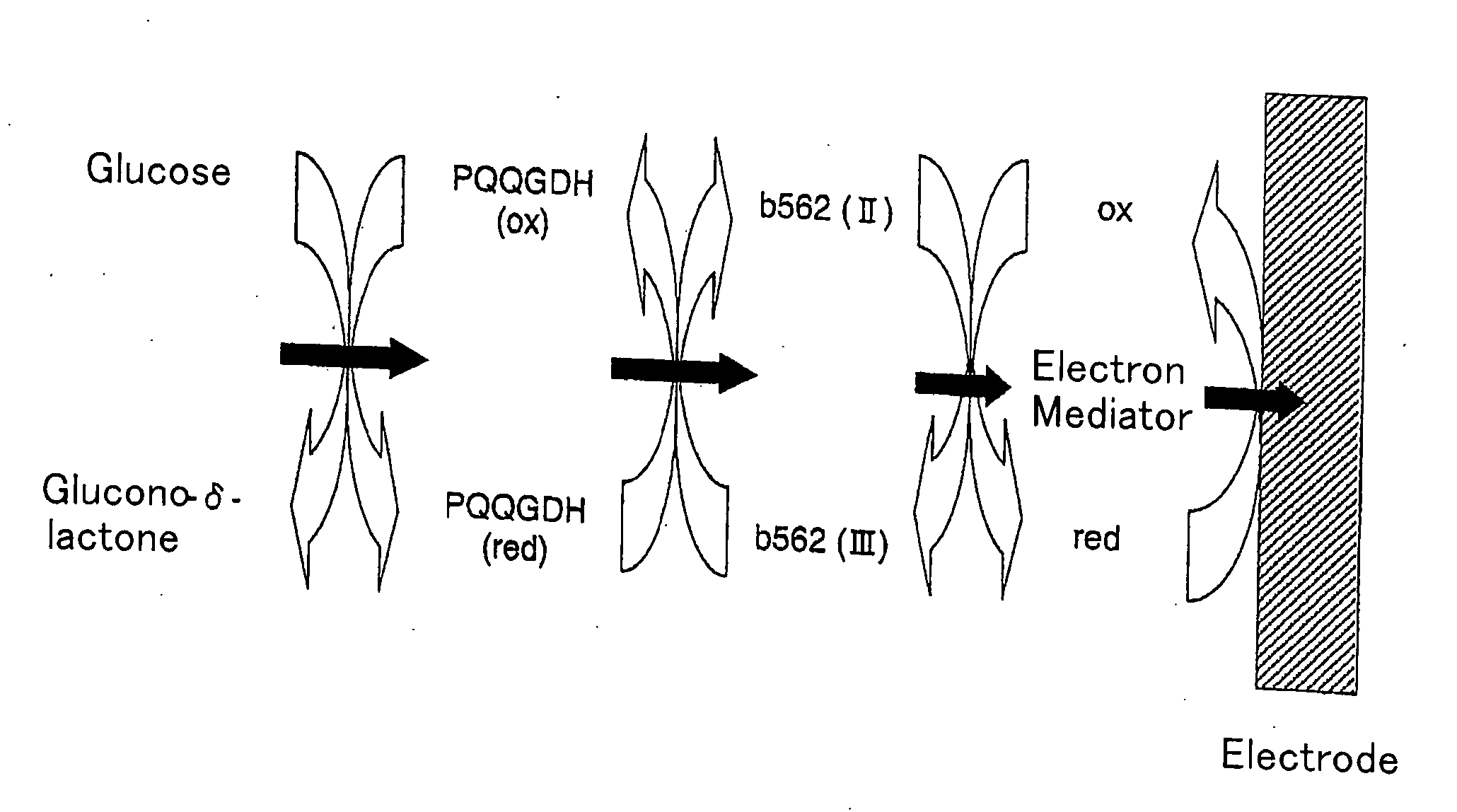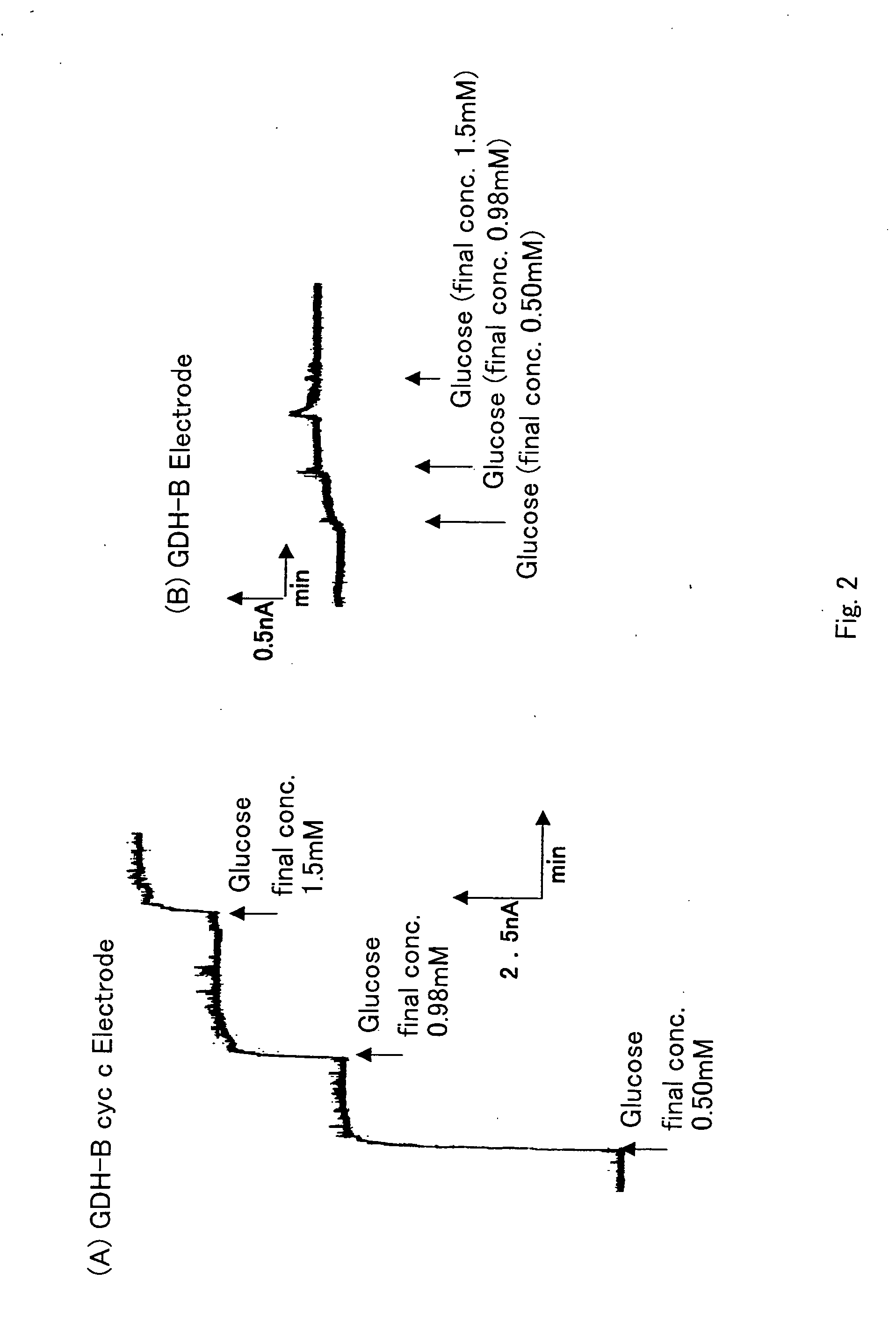Oxygen electrode
a biosensor and electrode technology, applied in the field of enzyme electrodes and biosensors, can solve the problems of slow electron transfer of oxidoreductases to electrodes, and low response currents of electrodes, and achieve the effect of high response valu
- Summary
- Abstract
- Description
- Claims
- Application Information
AI Technical Summary
Benefits of technology
Problems solved by technology
Method used
Image
Examples
example 1
Preparation of Recombinant Cytochrome b562
[0045] According to Nikkila, H., Gennis, R. B. and Sligar, S. G., Eur. J. Biochem. 202 (2), 309-313 (1991) and Tower, M. K., Biochem. Biophys. Acta. 1143, 109-111 (1993), the following two sets of oligonucleotide primers were synthesized, and each was used for genomes of Escherichia coli, i.e., Escherichia coli DH5a strain (E. coli K strain) and Escherichia coli B strain to amplify the structural region of cytochrome b562 by the PCR method. The genomic DNA was extracted from respective Escherichia coli cells using a conventional method. As PCR primers, a primer that contains a sequence recognized by the restriction endonuclease Nco I and a sequence that amplifies and adds a region of E. coli B strain-derived signal sequence for secreting cytochrome b562 (B CybC Fw NcoI), and a primer that does not contain the signal sequence (CybC Fw w / o SP) were designed for the forward primers, and primers that contain a sequence recognized by the restric...
example 2
Construction of an Enzyme Electrode in Which PQQGDH and Cytochrome C Have Been Immobilized
[0052] To an enzyme solution (3900 U / mg protein) of Acinetobacter calcoaceticus-derived water-soluble PQQGDH purified according to conventional method, was added 1 μM PQQ and 1 mM CaCl2 at a final concentration, and incubated for 30 minutes at room temperature under dark conditions. The enzyme solution was dialyzed overnight against 100 volumes of a 10 mM MOPS buffer solution (pH7.0) containing 1 mM CaCl2. Horse heart-derived cytochrome C (hereafter may be indicated by cyt.c) purchased from Sigma (No. C-7752) was dissolved in 10 mM MOPS buffer solution (pH7.0) at a final concentration of 1 mM, and was dialyzed overnight against 100 volumes of a 10 mM MOPS buffer solution (pH7.0).
[0053] PQQGDH (25 units, 0.64×10−10 mol) and cyt.c sample (100 times molar excess to the enzyme, i.e. 0.64×10−8 mol) prepared in this way were mixed together with 20 mg of carbon paste and lyophilized. After thorough ...
example 3
Measurement of Glucose Using a Sensor Constructed from PQQGDH, Cytochrome C (cyt.c) and Potassium Ferricyanide as an Electron Mediator
[0055] A 10 mM MOPS buffer solution (pH7.0) containing 1 mM CaCl2 was placed in a constant temperature cell, potassium ferricyanide was added as a mediator at a final concentration of 10 mM, and the total volume was made to be 10 ml. The carbon paste electrode (enzyme electrode) constructed in Example 2, in which PQQGDH and cytochrome C are immobilized, as the working electrode, a platinum electrode as the counter electrode and an Ag / AgCl electrode as the reference electrode were inserted therein to construct the sensor.
[0056] Measurements were all performed at 25° C. An electric potential of +400 mV vs Ag / AgCl was applied. When the current became stationary, the current value that increased with the addition of different concentrations of glucose was measured. The current value when glucose was not added was defined as 0 A.
[0057] The enzyme electr...
PUM
| Property | Measurement | Unit |
|---|---|---|
| molecular weight | aaaaa | aaaaa |
| total volume | aaaaa | aaaaa |
| electric potential | aaaaa | aaaaa |
Abstract
Description
Claims
Application Information
 Login to View More
Login to View More - R&D
- Intellectual Property
- Life Sciences
- Materials
- Tech Scout
- Unparalleled Data Quality
- Higher Quality Content
- 60% Fewer Hallucinations
Browse by: Latest US Patents, China's latest patents, Technical Efficacy Thesaurus, Application Domain, Technology Topic, Popular Technical Reports.
© 2025 PatSnap. All rights reserved.Legal|Privacy policy|Modern Slavery Act Transparency Statement|Sitemap|About US| Contact US: help@patsnap.com



